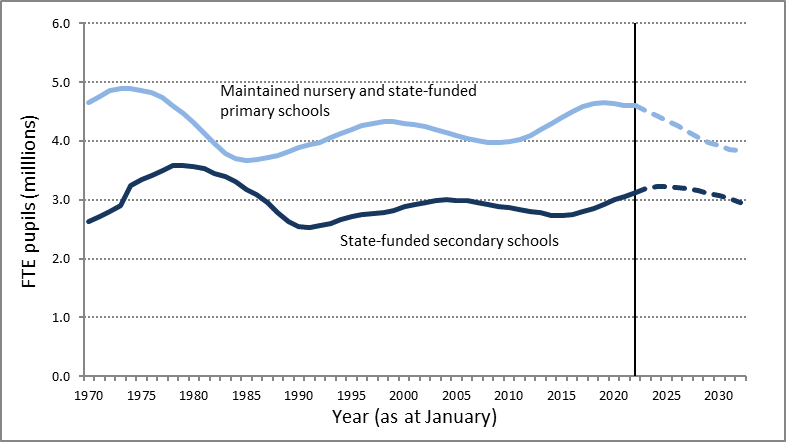Actual (2022) and projected pupil numbers by school type, England
| 2022 | 2023 | 2024 | 2025 | 2026 | 2027 | 2028 | 2029 | 2030 | ||
| State-funded nursery & primary schools | 4,597 | 4,527 | 4,441 | 4,352 | 4,259 | 4,163 | 4,065 | 3,983 | 3,917 | |
| year on year change | -70 | -86 | -89 | -93 | -96 | -98 | -82 | -66 | ||
| State-funded secondary schools | 3,126 | 3,191 | 3,230 | 3,228 | 3,219 | 3,196 | 3,163 | 3,116 | 3,070 | |
| year on year change | 65 | 39 | -2 | -9 | -23 | -33 | -47 | -46 | ||
| State-funded special schools | 125 | 128 | 130 | 130 | 129 | 128 | 126 | 124 | 122 | |
| year on year change | 3 | 2 | 0 | -1 | -1 | -2 | -2 | -2 | ||
| Alternative provision settings | 11 | 12 | 12 | 13 | 13 | 13 | 13 | 12 | 12 | |
| year on year change | 1 | 0 | 1 | 0 | 0 | 0 | -1 | 0 | ||
| Total state-funded schools | 7,859 | 7,858 | 7,814 | 7,723 | 7,620 | 7,500 | 7,367 | 7,236 | 7,122 | |
| year on year change | -1 | -44 | -91 | -103 | -120 | -133 | -131 | -114 | ||
- The actual population in state-funded schools in 2022 was 7,859,000. This is projected to decrease by 944,000 (to 6,915,000) over the next ten years to 2032.
- The projection model published in 2021 estimated a population of 7,269,000 in 2032[1], so the updated model shows a decrease of 354,000 on the total at the end of its projection period.
- The difference is primarily due to notably lower birth projections in the mid-2020 ONS national population projections, used for the first time in this set of pupil projections, which are the main drivers of the pupil population.
- The following headlines focus on projections up to 2028 in recognition of the increased uncertainty in projections beyond this point.
Early years figure
- This age group includes 4 year olds in reception class, which virtually all children attend, as well as the younger ages. Overall it has a higher proportion of children attending part-time and therefore is best reported as a full-time equivalent (FTE) population.
- On that basis the FTE population of under 5 year olds in state funded education is projected to be 721,000 in 2028. This is 13.2% lower than the actual figure for 2022 (830,000).
- This population decrease is due to the lower number of births, both actual to 2020 and also projected into the future by ONS.
State-funded nursery & primary schools
- The overall population in these school types is projected to be 4,065,000 in 2028. This is 532,000 lower than the actual figure in 2022 (4,597,000).
- The figure for 2028 is 168,000 lower than was forecast in the model published in 2021, a difference of -4.0%.
State-funded secondary schools
- The secondary school population is projected to be 3,163,000 in 2028. This is 37,000 higher than the total in 2022 (3,126,000).
- The figure for 2028 is 4,000 lower than was forecast in the model published in 2021, a difference of -0.1%.
- The pattern of change in the secondary school population (peaking in 2024 then very slowly starting to drop) is unchanged.
[1] Figure not previously published
Time series of actual and projected nursery & primary and secondary school population
